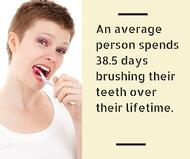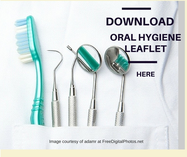 You can't overestimate the importance of good oral hygiene -- not only for good oral health, but for your overall wellbeing. Gum disease is a major risk factor for the development of serious health conditions such as heart disease and diabetes.
You can't overestimate the importance of good oral hygiene -- not only for good oral health, but for your overall wellbeing. Gum disease is a major risk factor for the development of serious health conditions such as heart disease and diabetes.
From the time we're young, we're taught that using a toothbrush regularly is one of the best ways to keep our teeth and gums healthy. But which toothbrush is best?
In the late 1930s, when toothbrushes with nylon bristles were first invented, consumers choosing a toothbrush didn't have many options. Today most shops sell an extensive collection of different toothbrushes, including manual (disposable) and powered (electric) varieties and a variety of oral hygiene products.
General Tips for Choosing a Toothbrush
There are certain characteristics that you should look for when choosing a toothbrush, regardless of whether it is manual or powered.
- The best toothbrush head should allow you easy access to all surfaces of your teeth. For most adults, a toothbrush head a half-inch wide and one-inch tall will be the easiest to use and the most effective. Larger toothbrush heads are available, but you may find that it is difficult to maneuver and to clean certain hard-to-reach areas, such as the sides and backs of your molars. Your toothbrush should have a long enough handle so you can comfortably hold it in your hand.
Bristle variety. For the vast majority of people, a soft-bristled toothbrush will be the most comfortable and safest choice. Depending on how vigorously you brush your teeth and the strength of your teeth, medium- and hard-bristled brushes could damage your gums, root surface, and protective tooth enamel. For even more tooth protection when you brush, be sure the bristles on your toothbrush have rounded tips.
Tips to care for you toothbrush.
1. Keep It Clean
You may not give much thought to cleaning your toothbrush, since you’re wetting it every day to scrub your teeth. However, it’s important -- and easy -- to do.
2.Wash it. Give your toothbrush a thorough rinse with tap water to remove debris. If you have a systemic illness or immune disorder, you may want to soak your toothbrush in an antibacterial mouthwash or run it through the dishwasher.
3.Try deep cleaning. There are many types of toothbrush sanitizers on the market, some use ultraviolet light to kill microorganisms.
4.Store it properly. After use, don’t pop your wet toothbrush back into your medicine cabinet, drawer, or bathroom cup and forget about it.Store it upright, in a rack or cup, where it can dry out. Look for a cover that lets air circulate and prevents mold, but isn’t completely sealed. The lack of air can foster bacteria.
5.When to Call It Quits
How long should you keep a toothbrush to prevent the ick from building up?
6.Know when to let go. Replace your toothbrush about every 3 to 4 months, or when it shows signs of wear. Frayed bristles will not clean the teeth and gums adequately.
7.Toss toothbrushes after illness. Throw away a brush you or anyone in your home used while sick.Yes, that means all toothbrushes. Treat electric or power models the same way you handle an old-fashioned one. Chuck the brush attachment after an illness or when the bristles begin to show signs of wear.
No Sharing
Tempted to lend a toothbrush to a family member? Don’t.Toothbrush sharing can transfer saliva and bacteria -- even the kind that cause tooth decay.


.png?width=320&name=Request%20(1).png)

